
Our trip to Tokyo & tea ceremony lesson
During Yuye and I’s March 2012 trip to Tokyo, we stayed at a hotel in Ueno (Tokyo Ueno New Izu Hotel) which I will blog about in a future post. The weather was still very cold and on one of the days it actually snowed. We weren’t prepared for this as we didn’t wear waterproof shoes. Just 10 minutes in the freezing slushy snow was enough to send us back to the hotel room, shaking and huddling. We were determined to not waste a day stuck in the hotel and decided to do a tea ceremony tutorial at a little tea shop just around the corner called Higashi Ueno Sankouen.
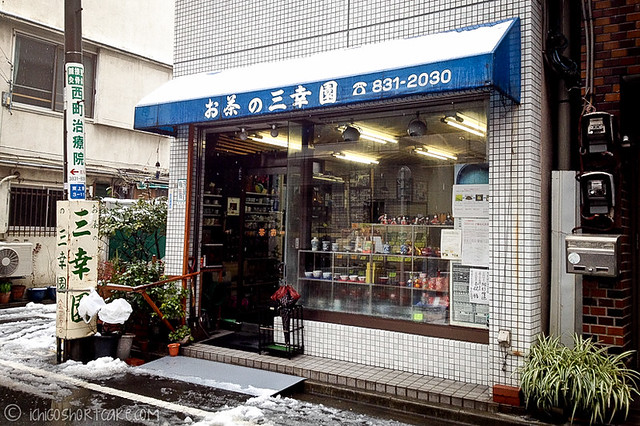
We were greeted by the loveliest man, Takeshi, who was very talkative. He was a bit wary of whether we were able to speak Japanese and there was a sigh of relief when we said we could speak and understood basic Japanese. We then proceeded to have many long conversations in between him teaching us about the tea ceremony, with topics such as temples and shrines, religious symbols and of course tea. We found out that he used to be a wagashi (Japanese sweets) maker but never found out the reason for him changing careers.
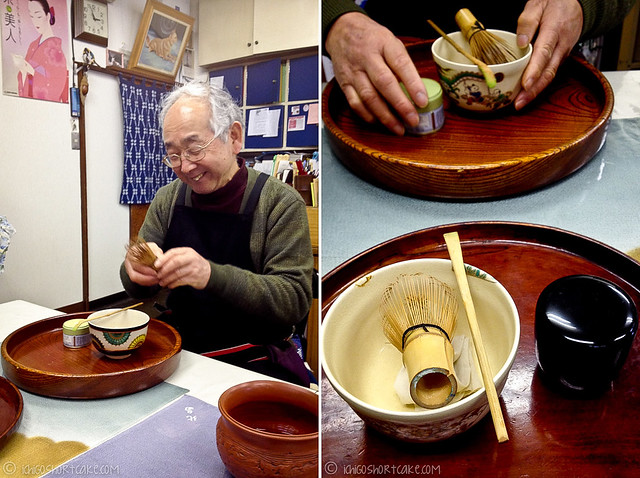
We stayed there for a long time and drank so much tea I needed to use their restroom. At 300Yen per person, I’m not sure how they actually make money!
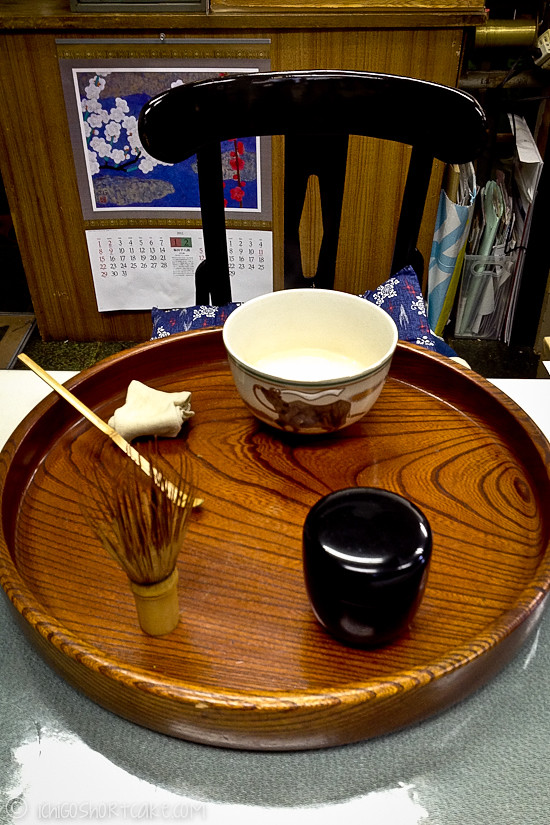
It wasn’t just matcha we drank, we were also provided with a sakura mochi – cherry blossom flavoured glutinous rice with a shiso leaf and red bean paste filling, it’s a popular wagashi served with green tea. It tasted a lot better than store bought versions as it was made with a fantastic and salty shiso leaf. The shiso was supposedly cured for over 12 months before it is served. The saltiness cut through the sweet red bean paste very well.
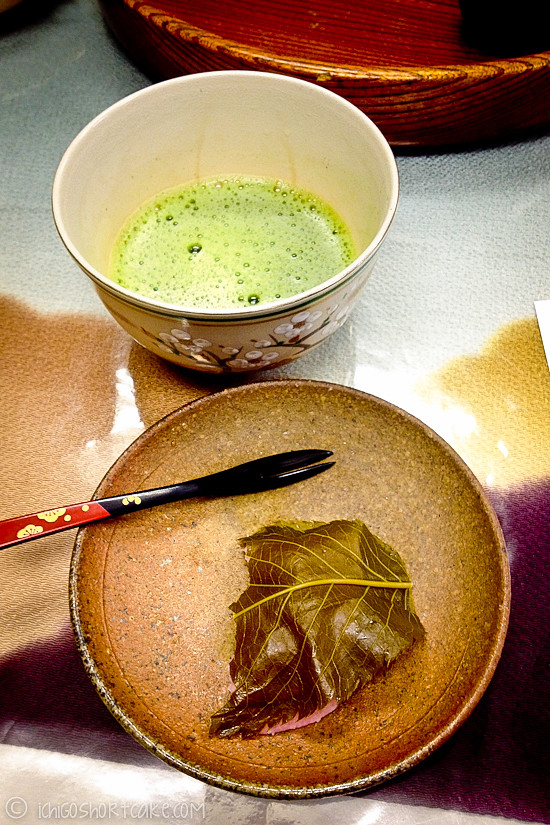
During that visit we purchased a few matcha making equipment such as the bowls, bamboo whisk and tea. The bowls are handmade and were not cheap. The one with the birds costed nearly $50AUD but I fell in love with it so it was an exceptional purchase. 😛
We went back a few more times after that first day and ended up walking away with lots of freebies such as more wagashi, free wagashi picks (the black ones) and cheap silver plated picks. I felt bad walking away with so many goodies though so hopefully next time I go back to Tokyo, I will bring them a little something as well. 
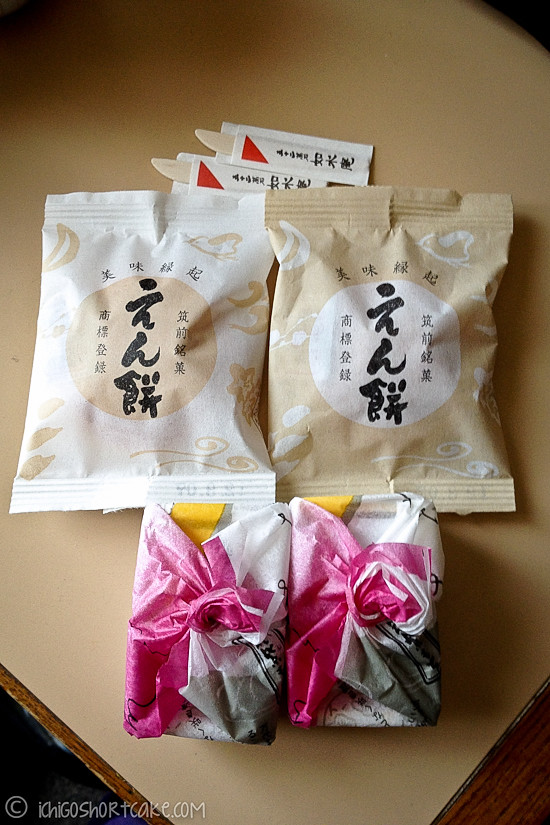

On another occasion, we were fortunate enough to have made the annual Tokyo Traditional Crafts Exhibition in Ikebukuro Tobu Department Store. The exhibition is usually held from the end of February and finish at the start of March every year. We got to see some amazing craftsmen at work that have come from all over Japan. They literally made their specialised crafts on the spot and showcased some amazing works that could be purchased.
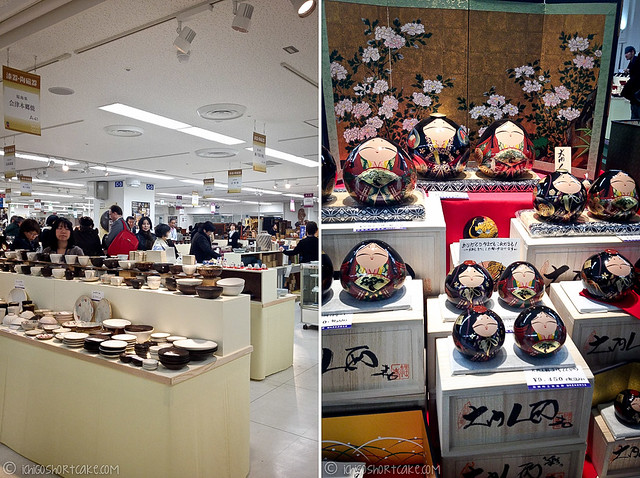
The crafts ranged from traditional hand painted kimono fabrics, hand made pottery, wooden furniture, traditional Japanese dolls and even the bamboo tea whisks were made on site. It was amazing to see them in action!


There were also many examples of step-by-step processes of how certain items are made which really interested us.
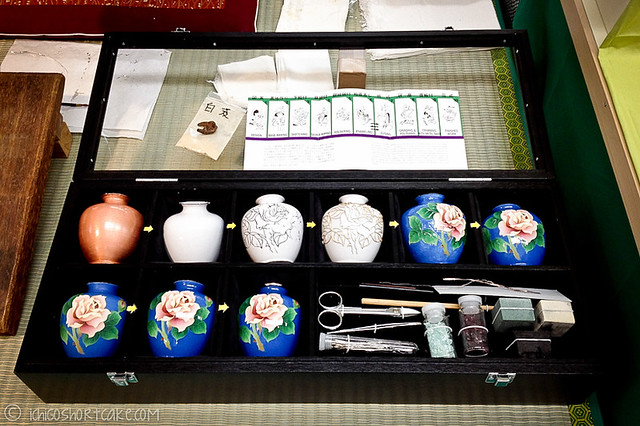
We ended up buying a few tea cups and saucers from this exhibition – they were probably the only things we could afford. Kimono fabrics could cost over $10,000AUD. Everything in the photo below were bought from Higashi Ueno Sankouen, apart from the 3 tea cups and 1 saucer on the top right hand corner.
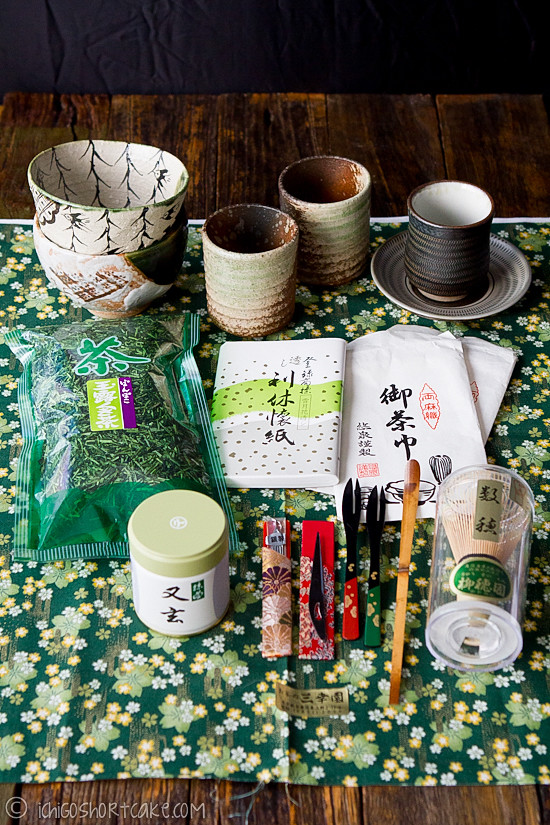
A bit of history about green tea and matcha (抹茶)
Green tea originated in China perhaps 5000 or so years ago* in the form of dried tea leaves mixed with hot water. It made its way to Japan in the 800’s and wasn’t until later that the matcha powder was developed. Matcha powder is produced through finely milled, high quality green tea leaves that are grown in the shade. This process creates extra amino acids being formed in the leaves and is what contributes to the taste.**
Matcha has traditionally been used in tea ceremonies and consumed with Japanese sweets (wagashi – 和菓子) but it has been used a lot to flavour desserts and other dishes. Most popular and well known dishes include green tea ice cream, mochi, and even soba noodles and lollies. Matcha powder can be purchased from most good Asian grocery store and the higher grade powders can often cost an arm and leg.
In traditional tea ceremonies, the green tea is prepared by the host and passed along to each guest in one single tea bowl. The bowl travels from one guest to another, wiping the lip mark clean as one is done drinking, until all guests have had a sip. There are very strict and intricate processes involved in the tea ceremony and its purpose is to promote tranquility, purity, harmony and respect. For more information on the tea ceremony, visit http://www.squidoo.com/japan-tea-ceremony
*http://www.green-teas-guide.com/history-of-green-tea.html
**http://en.wikipedia.org/wiki/Matcha
My take on how to prepare a good cup of matcha
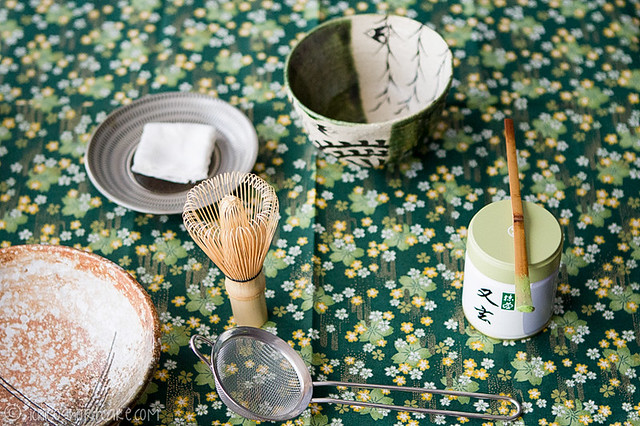
Ok, so I know I’m no expert. In fact, it’s the opposite. But with the appropriate utensils and a good box of matcha powder, it’s actually pretty easy to make a good cup of matcha. I’ve watched a few youtube videos on how to prepare it and it seems like a lot of people do it slightly differently. I was also taught slightly different by Takeshi in Tokyo. One thing is for sure, there are specific utensils that go into this sacred process. How I’m preparing this (and how I was taught) is quite casual and for home users so it’s somewhat of an evolved form than the traditional processes.
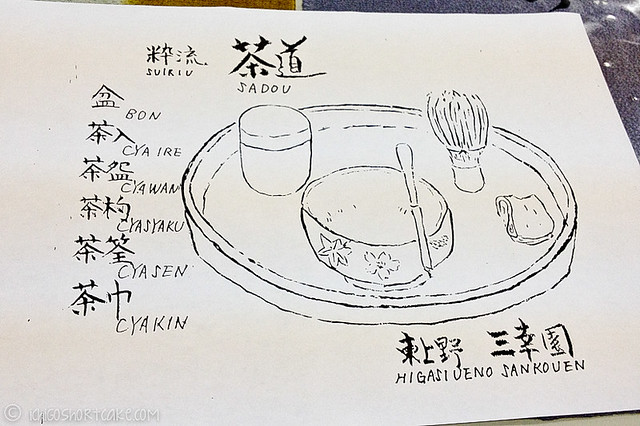
What you will need
Sadou means the way of tea and the utensils Takeshi mentioned in his picture are as follows:
• Bon – tray (it’s the big round tray that holds all the other utensils), I didn’t have this and I don’t think it’s necessary
• Cya Ire (or cha ire) – tea caddy
• Cya Wan – tea bowl
• Cyasyaku (or cha shaku) – bamboo scoop for the tea powder
• Cya Sen (cha sen) – bamboo matcha whisk
• Cya kin (cha kin) – cotton cloth for wiping tea bowl
You will also need a small sifter to sift the green tea powder and a large bowl to pour waste water into and of course, good matcha powder.
You can substitute most of these utensils with existing household items, ie. a regular bowl (that’s large enough to use the whisk), a regular tea spoon to scoop the powder and a regular cloth to wipe the bowl. However, you should have a reasonable bamboo whisk to make matcha properly.
Here’s a little video I filmed yesterday, it’s the first time I attempted an informative video. You can laugh at me! I laughed at myself a lot. I don’t even want to replay it, it’s just so embarrassing, but here it is anyway. 😛
“And now I’m going to………..” I’m going to what?! So many words were going through my head as I started WHISKING. Why couldn’t I have thought of that word when the film was rolling? Ahem. Anyhow, that’s what I was trying to say. 😛
Here’s a step by step of how to do it in words:
1. Have a pot of boiled (very hot) water ready. Lay out the utensils in roughly the same way that I did.
2. Pour a little bit of hot water into the bottom of the bowl. Swirl it around the bowl to warm it up and clean it at the same time. Pour out the water into the extra bowl.
3. Pick up the cotton cloth and wipe the edges as well as the inside so it’s dry and clean.
4. Put a sifter on top of the bowl. Using the bamboo scoop, pick up 2 scoops of matcha powder and put it in the sifter. Sift powder through.*
5. Pour roughly 60mls (or to about quarter full) of hot water into the tea bowl.
6. Using the bamboo whisk, first slowly moved it around in the mixture in a horizontal 8 shape, do this a few times.
7. Then start whisking very quickly – in an M shape, up and down – for roughly 10-20 seconds, or until there’s a light and fluffy layer of foam on top.
8. Serve to a guest with the front of the bowl facing them, or if serving to yourself, the front should face you. Lift up the bowl with your left hand underneath the bowl, right hand on the side to stable it. Holding it with the right hand, turn the bowl from 12 O’clock to 3 O’clock (I believe it’s so to turn the front back to the guest but I’m not exactly sure why they do this) once, twice or 3 times depending on who the teacher is (I did mine twice). Slowly lift it the bowl up to your mouth and drink.
9. Serve hot with wagashi or biscuits like I have. Mind you, you don’t really need the wagashi pick in the photo if you’re serving it with biscuits as it really wouldn’t cut through them! I just thought they looked pretty. 😛
*Note, this sifting process is usually done before the ceremony as it’s quite impolite to have the sifter there (not to mention it’s quite loud). I just didn’t have another tea caddy to put the powder in.
Here is another youtube video that is 100 times better than what I filmed if you’re interested.

Question time: Have you ever had proper matcha green tea before? How do you like it compared to regular tea leaf tea?
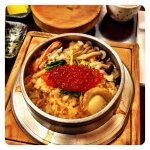










tastyfoodsnaps August 1, 2012, 6:48 pm
Matcha is my favourite! But the cherry blossom one does sound lovely
Iron Chef Shellie August 1, 2012, 8:22 pm
What a great post!
I’ve never had it to drink, only bought the powder to bake with… but after reading this, I really want to try it!
Christine August 1, 2012, 8:50 pm
I once did a tea ceremony with maiko and another where they showed you how to make the matcha – they had such an intricate method of making the matcha with so many steps I can barely remember how they did it lol
Ali August 1, 2012, 9:50 pm
What a great idea for something to do whilst travelling when the weather is cold out! I love Tokyo…it has been far too long since I have been there, though, and should I get back there one day, I must remember to try a tea ceremony xx
Hotly Spiced August 1, 2012, 10:00 pm
It does sound like it was terribly cold and not what we are used to here in Sydney. The Japanese present everything so beautifully. It all looks amazing and like it’s been done to perfection xx
Belinda @zomppa August 1, 2012, 11:01 pm
Wow!! I am so impressed. Everything is so beautiful, I love the care. I need to go to Japan!!
kitchenriffs August 2, 2012, 6:43 am
Terrific post! And the video was great. I’ve not had matcha before, but I’m going to have to. Great way to spend time when the weather is bad. I always enjoy looking at pictures of other people’s vacations, too, so keep them coming! Thanks.
Lorraine @ Not Quite Nigella August 2, 2012, 7:10 am
Great post! It really illustrates why I love Japan so much. They do things with such care and thoughtfulness
yummychunklet August 2, 2012, 8:31 am
I love matcha green tea, especially when the powder is used on frozen yogurt!
Carolyn Jung August 2, 2012, 11:28 am
I love the bitter-sweet taste of matcha. But even more, I love the whole ceremonial process. It’s mesmerizing and can’t help but put you in a tranquil mood.
love2dine August 2, 2012, 2:03 pm
thanks a lot for sharing.
Rosa August 3, 2012, 12:38 am
A beautiful postr and lovely tradiion! I have never had matcha tea, but I use the powder in baked goods and desserts. Thanks for sharing!
Cheers,
Rosa
Julie August 3, 2012, 11:30 am
Amazing photos, love reading this and hearing about how it’s prepared. I love matcha tea!
and hearing about how it’s prepared. I love matcha tea!
Nami | Just One Cookbook August 3, 2012, 4:05 pm
GREAT post Jenny! I thoroughly enjoyed it especially video! You did a great job and if you didn’t tel me all the flaws I even don’t notice at all! I used to go to tea ceremony with my grandma because she belonged to some kind of group. I had fun dressing up and follow grandma and your post gave me nice flashbacks. The reason why wagashi is a little sweet and taste that way is to accompany with bitter matcha. So in a way, they compliment to each other.
Typically the mochi with cherry blossom flavor is wrapped with cherry blossom leaves (桜の葉 sakura no ha). Maybe this one also from the look of it – it does look like shiso too, but usually it’s made with sakura leaves.
I really hope to be in Japan when you visit next time. I wish to tag along because you go to such a fun places (I would normally pass by this kind of neighborhood shop – how fun that you went in!). I really love this post, and great tutorial on how to drink matcha!!
Agnes August 5, 2012, 10:14 pm
We tried proper matcha at a tea ceremony demonstration in Kyoto – the whole experience was amazing. It’s one of my favourite Japan memories.
Silvia August 7, 2012, 1:07 am
It was such a delight to read your post. It was just yesterday when my husband and I were drinking matcha tea and dreaming of how wonderful it would be if we make a trip to Japan some day, so now your Japan experience stirred further my dreams